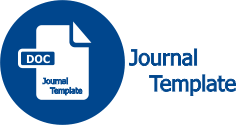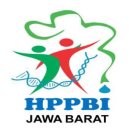Antibacterial Activity of Guava Leaf Extract on The Growth of Aeromonas Hydrophila
DOI:
https://doi.org/10.25134/quagga.v15i2.18Keywords:
Daun Jambu Biji, Aktivitas Antibakteri, Bakteri Aeromonas hydrophilaAbstract
Research on the benefits of guava leaves has been widely carried out because of their ability as an antibacterial and antifungal agent, especially in aquaculture. This study aims to determine the antibacterial activity of guava leaf extract against the growth of the pathogenic bacteria Aeromonas hydrophila in vitro. The method used to determine the antibacterial activity of guava leaf extract is the disc diffusion method. The activity test used a completely randomized design (CRD) consisting of 4 treatments with concentrations of guava leaf extract, namely 30%, 50%, 100%, and aqua dest as a control. Guava leaf extract was dissolved using 96% ethanol by the maceration method. Each treatment concentration was tested for its inhibitory power by calculating the apparent zone diameter that appeared against Aeromonas hydrophila bacteria. The data obtained were analyzed using analysis of variance with a 95% confidence level and, if significantly different, continued with the LSD test. The in vitro antibacterial activity test showed that guava leaf extract had a very significant effect on the growth of Aeromonas hydrophila bacteria (p<0.01) with a concentration of 50%, resulting in the most effective inhibition Aeromonas hydrophilla bacteria growth with a clear zone formed 18.33 mm. Based on the study results, it can be concluded that in vitro guava leaf extract with a concentration of 50% can inhibit the growth of Aeromonas hydrophila bacteria with the most significant clear zone yield.
References
Apriliyanti, P., Sarjito, & Prayitno, S. B. (2013). Identifikasi Bakteri Agensia Penyebab Motile Aeromonas Pada Ikan Lele Dumbo (Clarias gariepinus) yang Berasal dari Kecamatan Rowosari, Kabupaten Kendal. Journal of Aquaculture Management and Technology, 2(2), 1–9.
Azis, T., Febrizky, S., & Mario, A. D. (2014). PENGARUH JENIS PELARUT TERHADAP PERSEN YIELD ALKALOID DARI DAUN SALAM INDIA (MURRAYA KOENIGII). Teknik Kimia, 20(2), 1–6.
Chandra, R. A., Yunita, R., & Wahyuni, D. D. (2018). DAYA ANTIBAKTERI EKSTRAK BUAH BELIMBING WULUH (Averrhoa bilimbi Linn) TERHADAP Methicillin Resistant Staphylococcus aureus. Essential: Essence of Scientific Medical Journal, 16(1), 43–47. https://doi.org/https://doi.org/10.24843/ESTL.2018.v16.i01.p08
Dani, I. W., Nurtjahja, K., & Zuhra, C. F. (2012). PENGHAMBATAN PERTUMBUHAN Aspergillus flavus DAN Fusarium moniliforme OLEH EKSTRAK SALAM (Eugenia polyantha) DAN KUNYIT (Curcuma domestica). Saintia Biologi, 1(1).
de Araújo, K., de Lima, A., Silva, J., Rodrigues, L., Amorim, A., Quelemes, P., dos Santos, R., Rocha, J., de Andrades, É., Leite, J., Mancini-Filho, J., & da Trindade, R. (2014). Identification of Phenolic Compounds and Evaluation of Antioxidant and Antimicrobial Properties of Euphorbia Tirucalli L. Antioxidants, 3(1), 159–175. https://doi.org/10.3390/antiox3010159
Evans, W. C. (2009). Pharmacognosy (16th ed.). Elsevier Ltd. http://dl.konkur.in/post/Book/MedicalScience/Trease-and-Evans-Pharmacognosy-16th-Edition-%5Bkonkur.in%5D.pdf
Fajri, N., Ayuzar, E., & Ezraneti, R. (2016). Efektivitas serbuk daun mahkota dewa (Phaleria macrocarpa) terhadap bakteri Edwardsiella tarda. Acta Aquatica: Aquatic Sciences Journal, 3(1), 23–25. https://doi.org/10.29103/aa.v3i1.334
Fratiwi, Y. (2015). THE POTENTIAL OF GUAVA LEAF (Psidium guajava L.) FOR DIARRHEA. Majority, 4(1), 113–118. https://juke.kedokteran.unila.ac.id/index.php/majority/article/view/510
Hargono, D. (2003). Beberapa Hasil Penelitian yang Mendukung Manfaat Tumbuhan Jambu Biji (Psidium guajava L.). JURNAL ILMU KEFARMASIAN INDONESIA, 1(1), 33–38. http://jifi.farmasi.univpancasila.ac.id/index.php/jifi/article/view/667
Maleki, S., Seyyedneja, S. M., Mirzaie Da, N., & Motamedi, H. (2008). Antibacterial Activity of the Fruits of Iranian Torilis leptophylla Against Some Clinical Pathogens. Pakistan Journal of Biological Sciences, 11(9), 1286–1289. https://doi.org/10.3923/pjbs.2008.1286.1289
Nofita, Tutik, & Garini, T. (2021). PENGARUH PEMILIHAN TEKNIK EKSTRAKSI DAUN JAMBU BIJI AUSTRALIA (Psidium guajava L.) TERHADAP AKTIVITAS ANTIOKSIDAN DENGAN METODE DPPH. Jurnal Farmasi Malahayati, 4(1), 12–22. https://doi.org/10.33024/jfm.v4i1.4382
Nuryani, S., Putro, R. F. S., & Darwani. (2017). Pemanfaatan Ekstrak Daun Jambu Biji (Psidium guajava Linn) Sebagai Antibakteri dan Antifungi. Jurnal Teknologi Laboratorium, 6(2), 41–45. https://doi.org/10.29238/teknolabjournal.v6i2.95
Paliling, A., Posangi, J., & Anindita, P. S. (2016). Uji daya hambat ekstrak bunga cengkeh (Syzygium aromaticum) terhadap bakteri Porphyromonas gingivalis. E-GIGI, 4(2), 229–234. https://doi.org/10.35790/eg.4.2.2016.14159
Qonita, N., Susilowati, S. S., & Riyandini, D. (2019). Uji Aktivitas Antibakteri Ekstrak Daun Jambu Biji (Psidium guajava L.) Terhadap Bakteri Escherichia coli dan Vibrio cholerae. Acta Pharmaciae Indonesia : Acta Pharm Indo, 7(2), 51. https://doi.org/10.20884/1.api.2019.7.2.2416
Rastina, Sudarwanto, M., & Wientarsih, I. (2015). AKTIVITAS ANTIBAKTERI EKSTRAK ETANOL DAUN KARI (Murraya koenigii) TERHADAP Staphylococcus aureus, Escherichia coli, dan Pseudomonas sp. Jurnal Kedokteran Hewan - Indonesian Journal of Veterinary Sciences, 9(2), 185–188. https://doi.org/10.21157/j.ked.hewan.v9i2.2842
Seme, L. A., Tangkonda, E., & Ndaong, N. A. (2020). Uji Aktifitas Ekstrak Daun Ketapang (Terminalia catappa) Sebagai Anti Bakteri Terhadap Pertumbuhan Escherichia coli dan Staphyloccocus aureus Secara In Vitro. Jurnal Veteriner Nusantara, 3(2), 137–144. https://ejurnal.undana.ac.id/index.php/jvn/article/view/3419
Sine, Y., & Fallo, G. (2016). Uji Aktivitas Antibakteri Ekstrak Daun Ketapang (Terminalia catappa L.) dan Daun Jambu Biji (Psidium guajava L.) terhadap Pertumbuhan Bakteri Aeromonas hydrophila. BIO-EDU: Jurnal Pendidikan Biologi, 1(1), 9–11.
Suhendra, C. P., Widarta, I. W. R., & Wiadnyani, A. A. I. S. (2019). PENGARUH KONSENTRASI ETANOL TERHADAP AKTIVITAS ANTIOKSIDAN EKSTRAK RIMPANG ILALANG (Imperata cylindrica (L) Beauv.) PADA EKSTRAKSI MENGGUNAKAN GELOMBANG ULTRASONIK. Jurnal Ilmu Dan Teknologi Pangan (ITEPA), 8(1), 27. https://doi.org/10.24843/itepa.2019.v08.i01.p04
Susanto, B., Setyadi, I., Syahidah, D., Marzuqi, M., & Rusdi, I. (2017). PENGGUNAAN BAKTERI PROBIOTIK SEBAGAI KONTROL BIOLOGI DALAM PRODUKSI MASSAL BENIH RAJUNGAN (Portunus pelagicus). Jurnal Penelitian Perikanan Indonesia, 11(1), 15. https://doi.org/10.15578/jppi.11.1.2005.15-23
Tampedje, A. A. ., Tuda, J. S. ., & Michael, A. L. (2016). UJI EFEK ANTIBAKTERI EKSTRAK DAUN JAMBU BIJI (Psidium guajava Linn.) TERHADAP PERTUMBUHAN KOLONI Streptococcus mutans. PHARMACON Jurnal Ilmiah Farmasi, 5(3), 222–228. https://doi.org/https://doi.org/10.35799/pha.5.2016.12995
Wahjuningrum, D., Solikhah, E. H., Budiardi, T., & Setiawati, M. (2010). Pengendalian infeksi Aeromonas hydrophila pada ikan lele dumbo (Clarias sp.) dengan campuran meniran (Phyllanthus niruri) dan bawang putih (Allium sativum) dalam pakan. Jurnal Akuakultur Indonesia, 9(2), 92–103.
Widarta, I. W. R., & Arnata, I. W. (2017). Ekstraksi Komponen Bioaktif Daun Alpukat dengan Bantuan Ultrasonik pada Berbagai Jenis dan Konsentrasi Pelarut. Agritech, 37(2), 148. https://doi.org/10.22146/agritech.10397
Yuliani, S., Udarno, L., & Hayani, E. (2003). KADAR TANIN DAN QUERSETIN TIGA TIPE DAUN JAMBU BIJI (Psidium guajava). Buletin Penelitian Tanaman Rempah Dan Obat, 14(1), 17–24. http://ejurnal.litbang.pertanian.go.id/index.php/bultro/article/view/1978
Yulisma, L. (2018). UJI EFEKTIVITAS ANTIBAKTERI EKSTRAK DAUN JAMBU BIJI LOKAL (PSIDIUM GUAJAVA L) TERHADAP PERTUMBUHAN STAPHYLOCOCCUS AUREUS DAN BACILUS SUBTILIS SECARA IN VITRO. Quagga : Jurnal Pendidikan Dan Biologi, 10(2), 1–5. https://doi.org/10.25134/quagga.v10i2.1296




















